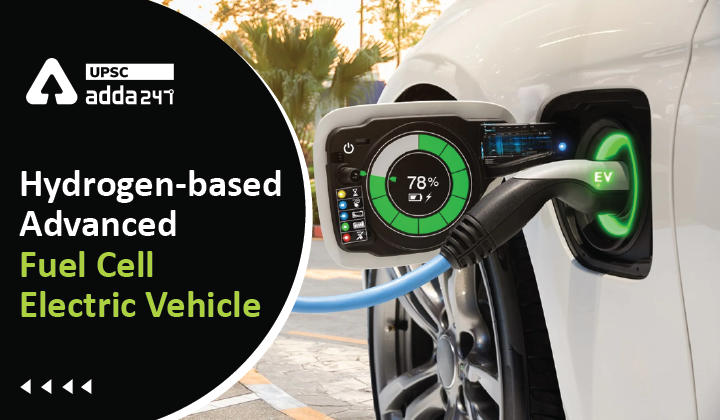Table of Contents
FCEV UPSC: Relevance
- GS 3: Achievements of Indians in science & technology; indigenization of technology and developing new technology.
FCEV India: Context
- Recently, Ministry of Road Transport & Highways has launched world’s most advanced technology – developed Green Hydrogen Fuel Cell Electric Vehicle (FCEV) Toyota Mirai, first of its kind project in India which aims to create a Green Hydrogen based ecosystem in the country.
Hydrogen vehicle: Key points
- Toyota Kirloskar Motor Pvt Ltd and International Center for Automotive Technology (ICAT) are conducting a Pilot Project to study and evaluate the world’s most advanced Fuel Cell Electric Vehicle (FCEV) Toyota Mirai which runs on hydrogen, on Indian roads and climatic conditions.
- The Toyota Mirai was launched in 2014, was one of the world’s first hydrogen fuel electric vehicles.
- This is a first of its kind project in India which aims to create a Green Hydrogen based ecosystem in the country by creating awareness about the unique utility of Green Hydrogen and FCEV technology.
What is FCEV?
- Fuel cell electric vehicles (FCEVs) are powered by hydrogen.
- They only emit water vapor and warm air.
- They are more efficient than conventional internal combustion engine vehicles and produce no tailpipe emissions.
- FCEVs use a propulsion system similar to that of electric vehicles, where energy stored as hydrogen is converted to electricity by the fuel cell.
FCEV India significance
- It is an important initiative which will promote clean energy and environmental protection by reducing dependence on fossil fuels and thereby make India ‘Energy Self-reliant’ by 2047.
- Fuel Cell Electric Vehicle (FCEV), powered by Hydrogen is one of the best Zero Emission solutions. It is completely environment friendly with no tailpipe emissions other than water.
What is green hydrogen?
- Green Hydrogen can be generated from renewable energy and abundantly available biomass. Introduction and adoption of technology to tap into the Green hydrogen’s potential will play a key role in securing a clean and affordable energy future for India.
Why Hydrogen?
- Combusting one kilo of hydrogen releases three times more energy than a kilo of gasoline and produces only water.
- Hydrogen fuel cells, which is an electrochemical cell that converts the chemical energy of hydrogen and oxygen into electricity, has only water as a waste product.
- Fuel cells can produce electricity continuously for as long as hydrogen and oxygen are supplied.
Production of Hydrogen
- 96 percent of hydrogen is produced from fossil fuels via carbon intensive processes.
- Based on extraction methods, the hydrogen produced is classified as ‘grey’, ‘blue’, or ‘green’ hydrogen.
- From fossil fuel, ‘grey’ hydrogen can be produced, which releases a lot of carbon dioxide.
- When carbon dioxide (CO2), given out during its production, is locked up through carbon capture and storage (CCS) processes, ‘grey’ hydrogen becomes ‘blue’ hydrogen.
- Both grey and blue hydrogen are produced by the same processes, the only difference for ‘blue’ hydrogen being that the CO2 produced is sequestered.
- Government is aiming to produce ‘green’ hydrogen, which is mostly produced from clean energy sources like renewables.
- The ‘green’ hydrogen is released via electrolysis of energy from renewable sources.
- The hydrogen produced from this method gives rise to no CO2 emissions, is expensive and not commercially viable
Steps taken by the government to promote hydrogen
- The central government has considered using 2000 megawatt solar and wind power capacity for producing hydrogen.
- Hydrogen auctions will be conducted to cut down greenhouse gas emissions as industries will be encouraged to use the technology to store electricity and also prospectively operate vehicles.
- Businesses such as the fertilizer and petroleum refineries will be mandated to buy 10% of their requirements of hydrogen from domestic sources of green hydrogen.
- Launch of National Hydrogen Energy Mission.
- Know about Green hydrogen, Grey hydrogen and Blue hydrogen from here.
- National Thermal Power Corporation Limited (NTPC) has signed a MoU with Siemens to use the company’s renewable energy plants to produce green hydrogen.
- Similarly, the Indian Oil Corporation will establish a plant with a capacity to produce one tonne of the hydrogen on a daily basis.
Recent news about hydrogen





 TSPSC Group 1 Question Paper 2024, Downl...
TSPSC Group 1 Question Paper 2024, Downl...
 TSPSC Group 1 Answer key 2024 Out, Downl...
TSPSC Group 1 Answer key 2024 Out, Downl...
 UPSC Prelims 2024 Question Paper, Downlo...
UPSC Prelims 2024 Question Paper, Downlo...
